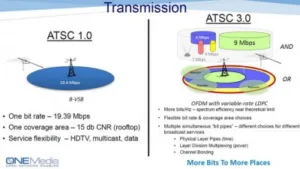Were you aware broadcasters still exist? I’m not talking about networks like CBS, ABC, NBC or Fox in the US. I’m talking about companies like WCBS-TV in New York that own transmitting antennas and send RF TV signals out into the wilderness in the hope that someone is watching using their receiving antenna and a digital television. Currently that television must have an ATSC 1.0 decoder in it to view the ATSC broadcast from WCBS or virtually any other television station in the nation.

ATSC 3.0 is an update to the original digital ATSC broadcast system. ATSC was developed in the time period from 1987 to mid-1990s and was formally adopted by the FCC as the broadcast standard to replace analog NTSC on December 26, 1996. It’s not surprising that ATSC is due for an update – every other 1990s digital standard has been updated. Remember Windows 95 from Microsoft? It was also developed in the mid-1990s and released August 24, 1995. It was considered a big improvement over Windows 3.1. Windows has been updated multiple times in the last 20 years, why shouldn’t the ATSC broadcast standard? That’s the basic idea behind ATSC 3.0.
 ATSC 1.0 Compared to ATSC 3.0
ATSC 1.0 Compared to ATSC 3.0
If you listen to ATSC 3.0 advocates, it has many advantages. One key change is ATSC 3.0 switches from the 8-VSB RF encoding scheme used in ATSC 1.0 to Orthogonal frequency-division multiplexing (OFDM). 8-VSB had its detractors since before ATSC was adopted, so this is not an unreasonable change. OFDM provides up to 90Mbps, essentially the theoretical maximum bit rate for a 6MHz RF channel, while 8VSB provides 19.4 Mbps. OFDM is widely used by cable, satellite, wireless LAN and, outside the US, terrestrial digital TV so we aren’t talking about some radically new technology with major risks. This high bit rate will allow ATSC to provide multiple simultaneous “bit pipes” and allow broadcasters to provide far more than just HDTV. In fact, as I understand it, HDTV will just be streamed through one of these bit pipes, like any other content or any other HDTV content source.
Unfortunately, ATSC 3.0 has one MAJOR disadvantage – it is not backward compatible with ATSC 1.0.
There have been somewhere around 300M TVs sold in the US since the transition from NTSC to ATSC started in 2008. Everyone of these TVs has an ATSC 1.0 decoder in it. 0M of these TVs has had a ATSC 3.0 decoder in it. If a broadcaster switches from ATSC 1.0 to ATSC 3.0, it will lose 100% of its viewers.
To most people, this will be no big deal. I haven’t watched over-the-air TV in years, myself. When I’m not watching a DVD or Blu-Ray disc, I’m watching signals streamed over the Verizon FIOS fiber optic network, the same system that provides me with Internet access. I’m not the only one in this situation, much to the distress of the broadcasters.
For the NTSC to ATSC transition, the US government required the broadcasters to switch from analog to digital and provided a lot of help to ensure the switch was relatively painless for both broadcasters and viewers. First, they provided a second broadcast channel to every broadcaster so they could simulcast the same content in analog and digital during the transition. Second, they provided many consumers with digital to analog conversion boxes so they could see the new content even on their old analog TV. Finally, they mandated the change and mandated that TV manufacturers include a ATSC decoder in every TV sold in the US. This guaranteed that every broadcaster had viewers and every viewer could see content from his broadcaster during the transition.
Details of the ATSC 1.0 to ATSC 3.0 transition haven’t been worked out yet. Even the ATSC 3.0 standard has not been finalized and isn’t likely to be before 2017, so it is unlikely the transition will take place in the next 5 years anyway. One thing the broadcasters I’ve talked to are certain about, however: The FCC will not provide them with a second broadcast channel during the transition. One day they will be broadcasting ATSC 1.0 and the next ATSC 3.0. If they have no or few viewers of ATSC 3.0 broadcasts, why should the FCC allow them to keep their broadcast spectrum? On the other hands, if they persist in broadcasting 19.4Mbps in a channel capable of broadcasting 90Mbps, why should the FCC allow them to keep their spectrum? A conundrum for the broadcasters, certainly. Anyone with the slightest knowledge of the market knows that the mobile wireless companies will be happy to take any spectrum they can and they will then fill it with content of all sorts: data, audio, TV, location-based services and viewers. –Matthew Brennesholtz
Editors Comment
We got this comment that takes another point of view on this topic. Next Generation Broadcast TV Platform Coming Soon – (BR)

